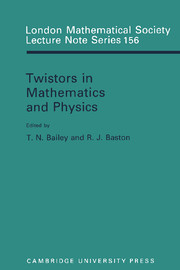Book contents
- Frontmatter
- Preface
- Contents
- 1 Twistor Theory After 25 Years—its Physical Status and Prospects
- 2 Between Integral Geometry and Twistors
- 3 Generalized Conformal Structures
- 4 Riemannian Twistor Spaces and Holonomy Groups
- 5 Twistors, Ambitwistors, and Conformal Gravity
- 6 The Penrose Transform
- 7 Notation for the Penrose Transform
- 8 The Twistor Transform
- 9 Invariant Operators
- 10 Penrose's Quasi-local Mass
- 11 The Sparling 3-form, Ashtekar Variables and Quasi-local Mass
- 12 Twistors and Strings
- 13 Integrable Systems in Twistor Theory
- 14 Twistor Characterization of Stationary Axisymmetric Solutions of Einstein's Equations
- 15 A Two-surface Encoding of Radiative Space-times
- 16 Twistors, Massless Fields and the Penrose Transform
- 17 Twistor Diagrams and Feynman Diagrams
- 18 Cohomology and Twistor Diagrams
- Authors' addresses
9 - Invariant Operators
Published online by Cambridge University Press: 05 May 2013
- Frontmatter
- Preface
- Contents
- 1 Twistor Theory After 25 Years—its Physical Status and Prospects
- 2 Between Integral Geometry and Twistors
- 3 Generalized Conformal Structures
- 4 Riemannian Twistor Spaces and Holonomy Groups
- 5 Twistors, Ambitwistors, and Conformal Gravity
- 6 The Penrose Transform
- 7 Notation for the Penrose Transform
- 8 The Twistor Transform
- 9 Invariant Operators
- 10 Penrose's Quasi-local Mass
- 11 The Sparling 3-form, Ashtekar Variables and Quasi-local Mass
- 12 Twistors and Strings
- 13 Integrable Systems in Twistor Theory
- 14 Twistor Characterization of Stationary Axisymmetric Solutions of Einstein's Equations
- 15 A Two-surface Encoding of Radiative Space-times
- 16 Twistors, Massless Fields and the Penrose Transform
- 17 Twistor Diagrams and Feynman Diagrams
- 18 Cohomology and Twistor Diagrams
- Authors' addresses
Summary
Introduction
Twistor theory, in both its flat and curved forms, [49] is principally a conformally invariant theory. This means that the associated differential geometry is somewhat weaker than the usual Riemannian geometry—the notion of distance is sacrificed whilst that of angle is preserved. This has certain advantages and disadvantages. To its credit, the weaker structure allows for greater generality—in two dimensions, for example, the notion of a Riemann surface is probably more useful than that of Riemannian geometry. Also, one may take a two step approach to problems in Riemannian geometry via conformal geometry. For instance one has the non-linear graviton construction [46] and the construction outlined in LeBrun's article in this volume whereby one first deals with a conformal manifold and then imposes additional structure to obtain Einstein metrics. A disadvantage is that conformal geometry is generally a good deal harder to work with; for instance, one no longer has the distinguished Levi Civita connection, its curvature, and the associated invariants. Instead one has to make do with the local twistor or Cartan conformal connection. This is not defined on the tangent bundle of the manifold but rather on an auxiliary bundle—the local twistor bundle. So at first sight it is not nearly as useful as the Levi Civita connection. It turns out, however, that one can use this connection and its curvature to obtain a large collection of tensor and differential invariants of a conformal structure which is more intriguing than its Riemannian counterpart and potentially more useful [17, 18, 29].
- Type
- Chapter
- Information
- Twistors in Mathematics and Physics , pp. 129 - 163Publisher: Cambridge University PressPrint publication year: 1990
- 11
- Cited by



